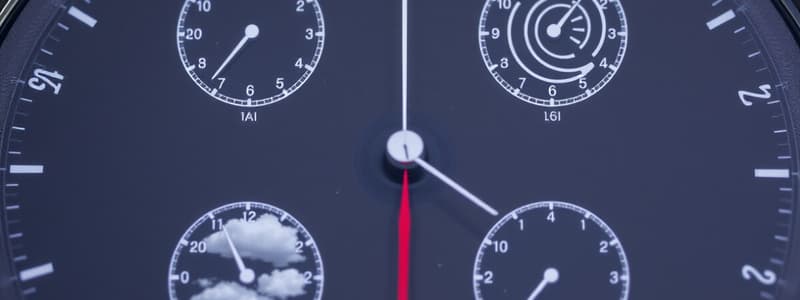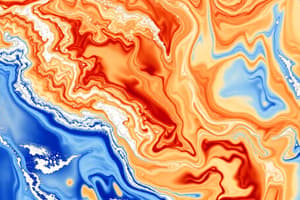Podcast
Questions and Answers
What causes variations in altimeter settings between weather reporting points?
What causes variations in altimeter settings between weather reporting points?
Unequal heating of the earth's surface
The wind at 5,000 feet AGL is southwesterly while the surface wind is southerly. This difference in direction is primarily due to?
The wind at 5,000 feet AGL is southwesterly while the surface wind is southerly. This difference in direction is primarily due to?
friction between the wind and the surface
Convective circulation patterns associated with sea breezes are caused by?
Convective circulation patterns associated with sea breezes are caused by?
cool, dense air moving inland from over the water
How will frost on the wings of an airplane affect takeoff performance?
How will frost on the wings of an airplane affect takeoff performance?
Every physical process of weather is accompanied by, or is the result of, a?
Every physical process of weather is accompanied by, or is the result of, a?
A temperature inversion would most likely result in which weather condition?
A temperature inversion would most likely result in which weather condition?
The most frequent type of ground or surface-based temperature inversion is that which is produced by?
The most frequent type of ground or surface-based temperature inversion is that which is produced by?
Which weather conditions should be expected beneath a low-level temperature inversion layer when the relative humidity is high?
Which weather conditions should be expected beneath a low-level temperature inversion layer when the relative humidity is high?
What is meant by the term 'dewpoint'?
What is meant by the term 'dewpoint'?
The amount of water vapor which air can hold depends on the?
The amount of water vapor which air can hold depends on the?
Clouds, fog, or dew will always form when?
Clouds, fog, or dew will always form when?
What are the processes by which moisture is added to unsaturated air?
What are the processes by which moisture is added to unsaturated air?
Which conditions result in the formation of frost?
Which conditions result in the formation of frost?
The presence of ice pellets at the surface is evidence that there?
The presence of ice pellets at the surface is evidence that there?
What measurement can be used to determine the stability of the atmosphere?
What measurement can be used to determine the stability of the atmosphere?
What would decrease the stability of an air mass?
What would decrease the stability of an air mass?
What is a characteristic of stable air?
What is a characteristic of stable air?
Moist, stable air flowing upslope can be expected to?
Moist, stable air flowing upslope can be expected to?
If an unstable air mass is forced upward, what type of clouds can be expected?
If an unstable air mass is forced upward, what type of clouds can be expected?
What feature is associated with a temperature inversion?
What feature is associated with a temperature inversion?
What is the approximate base of the cumulus clouds if the surface air temperature at 1,000 feet MSL is 70 degrees F and the dewpoint is 48 degrees F?
What is the approximate base of the cumulus clouds if the surface air temperature at 1,000 feet MSL is 70 degrees F and the dewpoint is 48 degrees F?
At approximately what altitude above the surface would the pilot expect the base of cumuliform clouds if the surface air temperature is 82 degrees F and the dewpoint is 38 degrees F?
At approximately what altitude above the surface would the pilot expect the base of cumuliform clouds if the surface air temperature is 82 degrees F and the dewpoint is 38 degrees F?
What are characteristics of a moist, unstable air mass?
What are characteristics of a moist, unstable air mass?
What are characteristics of unstable air?
What are characteristics of unstable air?
A stable air mass is most likely to have which characteristic?
A stable air mass is most likely to have which characteristic?
The suffix 'nimbus,' used in naming clouds, means?
The suffix 'nimbus,' used in naming clouds, means?
Clouds are divided into four families according to their?
Clouds are divided into four families according to their?
The boundary between two different air masses is referred to as a?
The boundary between two different air masses is referred to as a?
One of the most easily recognized discontinuities across a front is?
One of the most easily recognized discontinuities across a front is?
One weather phenomenon which will always occur when flying across a front is a change in the?
One weather phenomenon which will always occur when flying across a front is a change in the?
Steady precipitation preceding a front is an indication of?
Steady precipitation preceding a front is an indication of?
What situation is most conducive to the formation of radiation fog?
What situation is most conducive to the formation of radiation fog?
If the temperature/dewpoint spread is small and decreasing, and the temperature is 62 degrees F, what type of weather is most likely to develop?
If the temperature/dewpoint spread is small and decreasing, and the temperature is 62 degrees F, what type of weather is most likely to develop?
In which situation is advection fog most likely to form?
In which situation is advection fog most likely to form?
What types of fog depend upon wind in order to exist?
What types of fog depend upon wind in order to exist?
Low-level turbulence can occur and icing can become hazardous in which type of fog?
Low-level turbulence can occur and icing can become hazardous in which type of fog?
Flashcards are hidden until you start studying
Study Notes
Altimeter Settings and Weather Variations
- Variations in altimeter settings between weather reporting points are caused by unequal heating of the earth's surface.
Wind Characteristics
- Wind direction differences at various altitudes, such as swesterly winds at 5,000 feet vs. southerly surface winds, result from friction between the wind and the surface.
Sea Breeze Circulation
- Convective circulation patterns due to sea breezes occur as cool, dense air moves inland from the water when land heats up more than water.
Impact of Frost on Airplane Takeoff
- Frost on an airplane's wings disrupts the smooth air flow, negatively affecting lift capabilities during takeoff.
Weather and Heat Exchange
- Every weather phenomenon involves an exchange of heat, indicating that heat is a critical factor in all physical weather processes.
Temperature Inversion Effects
- Temperature inversions can lead to clouds with extensive vertical development above the inversion layer.
Ground-Based Temperature Inversions
- The most common type of ground-based temperature inversion occurs due to terrestrial radiation on a clear night when the ground cools rapidly.
Weather Beneath Inversion Layers
- Beneath low-level temperature inversion layers with high relative humidity, smooth air, poor visibility, fog, haze, and low clouds are typical conditions.
Dew Point Definition
- Dewpoint is defined as the temperature air must be cooled to in order to reach saturation.
Water Vapor Capacity
- The capacity of air to hold water vapor is directly proportional to its temperature.
Condensation and Cloud Formation
- Clouds, fog, or dew form whenever water vapor condenses.
Moisture Addition Processes
- Evaporation and sublimation are key processes that add moisture to unsaturated air.
Frost Formation Conditions
- Frost occurs when the surface temperature meets or falls below the dewpoint of nearby air, and the dewpoint is also below freezing.
Ice Pellets Evidence
- The presence of ice pellets at the surface indicates a temperature inversion with freezing rain occurring at a higher altitude.
Atmospheric Stability Measurement
- The actual lapse rate serves as a measurement of atmospheric stability. Stability indicates resistance to vertical displacement, while lapse rate reflects temperature changes with altitude.
Factors Reducing Stability
- Warming from below decreases the stability of an air mass.
Characteristics of Stable Air
- Stable air is characterized by stratiform clouds, contrasting with unstable air, which features cumulus clouds and good visibility.
Moist Air and Cloud Formation
- Moist, stable air flowing upslope typically results in stratus-type clouds.
Clouds in Unstable Air Masses
- An unstable air mass forced upward produces clouds with significant vertical development and turbulence.
Temperature Inversion Characteristics
- A temperature inversion is associated with a stable air layer.
Cloud Base Calculations
- The base of cumulus clouds can be estimated using the difference between temperature and dewpoint, adjusted for altitude; for instance, with a temperature of 70°F and dewpoint of 48°F, the cloud base is around 6,000 feet MSL.
Cumuliform Cloud Base Prediction
- If surface air temperature is 82°F with a dewpoint of 38°F, the expected base of cumuliform clouds is about 10,000 feet AGL.
Unstable Air Characteristics
- A moist, unstable air mass is characterized by cumuliform clouds and showery precipitation.
Attributes of Unstable Air
- Unstable air features turbulence and good surface visibility, as lifting motions create turbulence while clearing clouds and pollutants.
Smooth Air in Stable Environments
- Stable air masses are likely to result in smooth air conditions due to resistance to lifting motion.
Cloud Classification
- Clouds are categorized into four families based on their height range.
Front Characteristics
- The boundary between different air masses is termed a front, which is often accompanied by a noticeable temperature change.
Weather Across Fronts
- Transitions across a front always entail a change in wind direction.
Steady Precipitation Indicators
- Steady precipitation before a front indicates the presence of stratiform clouds and minimal turbulence, typical of stable air conditions.
Radiation Fog Formation
- Radiation fog forms in conditions of warm, moist air over low-lying areas during clear, calm nights, as moist air cools to its dewpoint.
Weather Indicators from Temperature/Dewpoint Spread
- A small and decreasing temperature/dewpoint spread, with the temperature at 62°F, likely leads to the development of fog or low clouds.
Advection Fog Formation
- Advection fog is most likely to form when a warm air mass moves inland from coastal areas during winter.
Wind Dependency for Fog
- Both advection fog and upslope fog depend on wind for their formation.
Low-Level Turbulence and Icing Hazards
- Steam fog can lead to low-level turbulence and hazardous icing conditions, occurring when cold, dry air moves over warmer water.
Studying That Suits You
Use AI to generate personalized quizzes and flashcards to suit your learning preferences.




